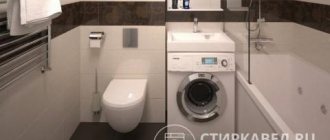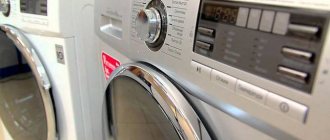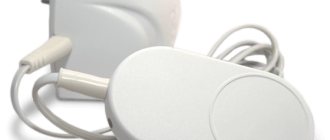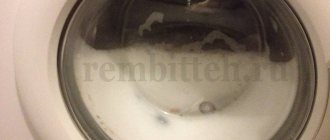The built-in washing machine is designed for installation in furniture; for this purpose, manufacturers have provided special fastenings for it. The body of the washing machine itself is hidden behind the doors or the facade of the unit - very convenient if you want to place the equipment in the kitchen and hide it from the eyes and curious kids. Our task is to find out the pros and cons of such devices, get acquainted with the criteria by which built-in machines are chosen, and select the best models from leading brands, focusing on user reviews. We will devote this review to choosing such a model.
Built-in SMA: how is it different from regular SMA?
The built-in version of the washing machine has the following advantages and positive differences compared to conventional equipment:
- Space saving. A pressing issue for owners of small apartments and the notorious Khrushchev kitchens of 6 square meters. This is also true for small bathrooms.
- Possibility of choosing a more spacious model . You will be able to afford a car with a large load without cluttering up the space in the room.
- Ease of connection to communications. All hoses are securely hidden in the cabinet along with the electrical appliance.
- Doesn't spoil the interior . Everything is clear here - the kitchen set looks laconic and modern, and guests do not watch their underwear rotating in the drum.
Are there any disadvantages? Definitely! And there is no point in hiding them:
- Such models are significantly more expensive than stand-alone devices.
- The assortment is not as rich as that of stationary SMs.
Where to install the machine
Washing “built-ins” are divided into 2 categories: fully built-in and those that are mounted under the countertop . In the first case, the machine is completely retracted into the set; at the manufacturing stage, it is possible to remove the top panel. The height of the legs of the device can be adjusted to suit the dimensions of the cabinet. The priority is the option when the machine is placed directly on the floor, and not on the base of the furniture, while the rear panel of the cabinet must be dismantled to ensure good ventilation.
In machines “under the table top” the top is also removable - if necessary, it is replaced by the plane of the table (an intermediate metal cover or a layer of ordinary foam rubber serves as waterproofing). The countertop can be part of a kitchen unit or belong to it. Many people try to bring the machine closer to the sink in order to simplify the connection to the water supply.
Installing a washing machine under the countertop
In the usual sense, built-in machines are intended for installation in the kitchen. However, sometimes, if space allows, they are left in the bathroom - for practical and aesthetic reasons. In this case, the device is fitted into a niche in a utility cabinet (for example, next to a water heater) or mounted under a common countertop with a washbasin. Whether to cover or leave the façade open is up to everyone to decide for themselves.
What about integrating a regular automatic machine?
If you want to hide your car, but it’s difficult to find a suitable model or you don’t like the cost of such a solution, then what should you do? In fact, a stationary machine CANNOT be built in - it does not have special hinges to implement this feature.
But you can install SMA in the kitchen under the countertop (if the top cover is removed or the height allows this) or in the bathroom under the sink - but even in this case you will have to fork out for a special model, the capacity of which is ridiculous, but the cost is not very interesting.
Of course, you can order a niche for installing a regular SMA from a furniture company, but an individual custom-made cabinet will cost you a lot, so we do not recommend this option and mark it as unprofitable .
Now you can see with the naked eye how a stationary structure differs from a built-in one, and if you are satisfied with the built-in design, it’s time to decide on the criteria for choosing a unit.
Built-in and conventional washing machines: differences
Many people are interested in the question: what is the difference between a built-in machine and a regular one? Functionally - nothing, that is, the units perform the same functions and are identical in use. The differences relate mainly to appearance, and before talking about them, it should be noted that built-in models are divided into two types:
- with the possibility of embedding;
- designed specifically for embedding.
Models from the first group outwardly look like ordinary washing machines, and they can be used without integration into a kitchen set. Such units are built under the countertop, for which the upper part of the body is removed. In some models, a special metal cover is installed between the countertop and the machine itself, which prevents moisture and grease from entering the internal parts of the equipment. The front part of such a washing machine is not covered by anything, so it turns out that the equipment is partially built-in.
Built-in appliances certainly save space in the kitchen
Units specifically designed for integration into furniture look a little different. There are special fasteners on the body of such equipment, for example on the front panel, to which the door will be attached, hiding the facade of the machine. The dimensions of a built-in washing machine are smaller than that of a regular washing machine, because it must be completely hidden inside a standard kitchen cabinet. At the bottom of the rear part of the case, such a unit usually has a special recess for the baseboard.
In the photo you can see a fully built-in washing machine
A significant difference between built-in models of washing machines is the low level of noise and vibration, especially during spinning. This effect is achieved through rigid fastening in furniture. And yet, many manufacturers install an additional leakage protection system in such models.
It should be noted that built-in appliances can be placed not only in the kitchen, but also in the bathroom, also by placing it under the countertop where the sink is installed, or by hiding it inside a special cabinet.
Selecting a built-in washing machine according to criteria
Before you make a purchase, pay attention to the following points:
- Case parameters (height, depth, width). Moreover, it is better not to trust the parameters specified in the product descriptions on the Internet, but to go to the store and personally measure the dimensions of the model you are supposed to buy with a tape measure.
- Drum loading limit .
- Classes: energy efficiency (your utility bills depend on this), washing (affects the quality of washing things), spin (the higher the class, the drier the laundry at the end).
- Additional functionality and options .
- Reviews from consumers who have already purchased the device and are using it successfully (or not so much). Information in reviews on websites should be “divided by two” - the comments are not always true.
Today on the household appliances market you can find offers with the following characteristics:
- Loading from 5 to 8 kg or more.
- Spin speed: low (from 800 revolutions per minute to 1200) and high (from 1200 revolutions or more).
- With drying. With such a machine, you don’t have to buy a dryer and hang clothes around the apartment or on the balcony.
- With quick wash function. Available in the entire range, and the duration of the fast program may vary - from 14 to 30 minutes per cycle.
- With control of imbalance and foaming. In equipment without these functions, if there is increased foam formation or things get lumped together, the machine stops working and you have to drain the water or disassemble the things. If the functionality is present, then the device itself combats these problems without “straining” the user.
- With or without display. A display is a convenient solution; if it is not there, it is almost impossible to find out the washing time and get complete information about the operation of the device. Also, error codes are displayed on the display, and in conventional washing machines you have to recognize faults by flashing lights, which is very inconvenient. But devices without a screen are cheaper.
- With partial or complete protection against leaks. Partial protection applies only to the housing, but with full protection, leakage is prevented in all systems, including hoses.
- With child protection. For families with children, this function is a must. But if you make a “cunning” lock in the locker, then the option will not be needed. Although, if the car has partial installation (when the control panel remains visible), you cannot do without locking the buttons.
- The energy consumption class can be either low - B and A, or high - A+, A++ or A+++. The more pluses, the less electricity the device consumes, and you save more on bills.
- Manufacturer. The most offers for built-in units in the middle and high price segment are brands such as Miele, LG, Siemens, Samsung, AEG, Electrolux. But you can also find a relatively inexpensive model from simpler brands - Hotpoint-Ariston, Indesit, Beko, Zanussi, Whirlpool, etc. When choosing a brand, you should focus not only on its popularity, but also on the reliability and degree of trust of users. In principle, all of the listed brands are well-known among domestic consumers and inspire confidence, and most importantly, they offer good cars.
The best built-in machines
Among built-in washing machines there are also leaders. We have selected the three best machines in terms of price-quality ratio, with optimal technical characteristics and a high rating among consumers. The TOP 3 included Weissgauff WMI 6148D, Bosch WIW 28540 and Siemens WI 14W540. They have both common features and individual advantages. So, the main powers and capabilities are almost the same:
- Capacity up to 8 kg.
- Energy consumption class – A+++.
- Washing efficiency level A.
- Digital display.
- The spin speed is 1400 rpm with the ability to vary until canceled.
- Complete protection against leaks.
- Has a child lock feature.
- Control of imbalance and foaming.
- Delay start timer.
- Plastic tank.
- Selecting the washing temperature mode.
- Sound accompaniment.
Now let's talk about the advantages of each model. The first - Weissgauff WMI 6148D - is compact and has a depth of 54 cm (3 cm narrower than its competitors). The low cost of about 30 thousand rubles, as well as the presence of the largest number of modes with 16 options, including the “My Program” self-tuning function, are also pleasing. The main “plus” is the honeycomb Water Cube Drum, designed to protect laundry from mechanical damage and improve the quality of washing. The hatch's wide diameter of 30 cm is impressive, making it easier to load and unload laundry.
The cost of Bosch WIW 28540 starts from 70 thousand rubles, which is explained by the reliability of the brand, touch controls and numerous additional options. Among the latest are the machine’s self-cleaning, TimeLight optical display and the non-contact modern EcoSilence Drive engine. The latter guarantees the new home assistant high energy efficiency, low power consumption, durability and noise levels in the range of 41-67 dB. The unique structure of the drum, made using VarioDrum technology, and a more stable body with the AntiVibration function are attractive.
Another feature of this model is the presence of internal drum lighting.
The German Siemens WI 14W540 can also boast of an optical display, a self-cleaning system and touch control. But the average price of this model is much lower and is within 60 thousand. Among the advantages are ideally selected modes with the ability to wash black items, outerwear, mixed fabrics and prevent wrinkles. Consumers enjoy a machine with fast but high-quality spinning and copious rinsing. It is also convenient to be able to easily stop the wash at any stage of the cycle and add forgotten items.
For those who value convenience, aesthetics and functionality, built-in washing machines will be the best option. In addition to the main feature - the possibility of embedding, "furniture" machines have other differences from conventional machines that simplify washing, installation and operation of equipment. The main thing is to know all the nuances of the chosen model and use all the provided functionality.
Interesting:
- Cabinet for washing machine in bathroom
- How to choose a cabinet for a washing machine in the kitchen
- How to choose a cabinet and install a dishwasher in it
- How to choose a brand of washing machine?
- Review of built-in washing machines
- How to install a washing machine in the kitchen and bathroom
Reader comments
- Share your opinion - leave a comment
Advantages and disadvantages of built-in washing machines
- They do not violate aesthetics.
- Safer from the point of view of operation (additional protective systems are installed that eliminate the possibility of leaks, strong vibration and foaming).
- Quite convenient in terms of location.
- High price.
- Small assortment (few models that differ in functionality).
Conventional (free-standing) washing machines are usually installed in apartment houses where there are no problems with free space or for cost-saving reasons. the price of conventional washing machines is significantly lower than that of built-in washing machines of a similar class.
Regular washing machine
In turn, conventional (free-standing) washing machines also come in two types:
- Washing machines with vertical loading (this design is more suitable for older people because there is no need to bend over when loading and unloading things. Machines of this design take up less space in the room).
- Front-loading washing machines (the design of this type of washing machine allows you to wash more clothes at a time due to its capacity).
There is a wider range of front loading washing machines on the market. Machines are available in various sizes (height, width and depth).
Thus, there is no fundamental functional difference between built-in and conventional washing machines. Usually the choice is made on a specific one based on the parameters of the home, aesthetic component and price.
Advantages and disadvantages of built-in washing machines
- They do not violate aesthetics.
- Safer from the point of view of operation (additional protective systems are installed that eliminate the possibility of leaks, strong vibration and foaming).
- Quite convenient in terms of location.
- High price.
- Small assortment (few models that differ in functionality).
Conventional (free-standing) washing machines are usually installed in apartment houses where there are no problems with free space or for cost-saving reasons. the price of conventional washing machines is significantly lower than that of built-in washing machines of a similar class.
Regular washing machine
In turn, conventional (free-standing) washing machines also come in two types:
- Washing machines with vertical loading (this design is more suitable for older people because there is no need to bend over when loading and unloading things. Machines of this design take up less space in the room).
- Front-loading washing machines (the design of this type of washing machine allows you to wash more clothes at a time due to its capacity).
There is a wider range of front loading washing machines on the market. Machines are available in various sizes (height, width and depth).











